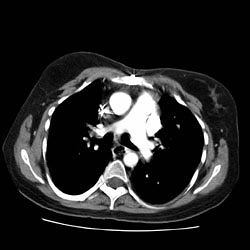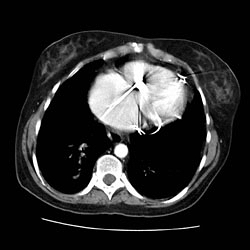Pulmonary nodule CT: Difference between revisions
Jump to navigation
Jump to search
No edit summary |
No edit summary |
||
| Line 30: | Line 30: | ||
</gallery> | </gallery> | ||
</div> | </div> | ||
====Halo Sign==== | |||
*The halo sign refers to a zone of ground-glass attenuation surrounding a pulmonary nodule or mass on CT images. | |||
*The presence of a halo of ground-glass opacity or ground-glass attenuation is usually associated with hemorrhagic nodules. | |||
*In severely neutropenic patients, the halo sign is highly suggestive of infection by an angioinvasive fungus, most commonly [[Aspergillosis | Aspergillus]]. | |||
*Vascular invasion by this fungus results in thrombosis of small- to medium-sized vessels, which causes ischemic necrosis. | |||
*At pathologic examination, the nodules represent foci of infarction, and the halo of ground-glass attenuation results from alveolar hemorrhage. | |||
*Although it is less common, the halo sign may also be observed in nonhemorrhagic nodules, in which case either tumor cells or inflammatory infiltrate account for the halo of ground-glass attenuation. | |||
Revision as of 14:45, 25 September 2012
|
Pulmonary Nodule Microchapters |
|
Diagnosis |
|---|
|
Treatment |
|
Case Studies |
|
Pulmonary nodule CT On the Web |
|
American Roentgen Ray Society Images of Pulmonary nodule CT |
Editor-In-Chief: C. Michael Gibson, M.S., M.D. [1]
Overview
CT

Halo Sign
- The halo sign refers to a zone of ground-glass attenuation surrounding a pulmonary nodule or mass on CT images.
- The presence of a halo of ground-glass opacity or ground-glass attenuation is usually associated with hemorrhagic nodules.
- In severely neutropenic patients, the halo sign is highly suggestive of infection by an angioinvasive fungus, most commonly Aspergillus.
- Vascular invasion by this fungus results in thrombosis of small- to medium-sized vessels, which causes ischemic necrosis.
- At pathologic examination, the nodules represent foci of infarction, and the halo of ground-glass attenuation results from alveolar hemorrhage.
- Although it is less common, the halo sign may also be observed in nonhemorrhagic nodules, in which case either tumor cells or inflammatory infiltrate account for the halo of ground-glass attenuation.





